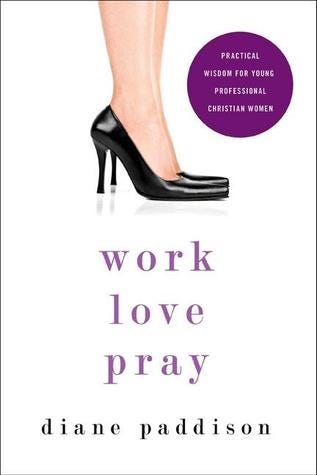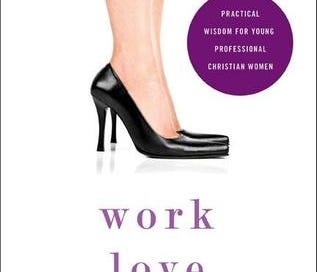Natasha's Study: Work Love Pray
Work Love Pray: Practical Wisdom for Professional Christian Women and Those Who Want to Understand Them
Why I picked up this book:

This book was gifted to me when I attended a women’s leadership summit a few years ago. Since that time, I have been paying attention to the author, Diane Paddison’s work through her nonprofit, 4Word Women. Who Should Read Work Love Pray: This book will be an encouragement to any Christian who is also a working woman. It addresses and provides practical advice and considerations for the daily struggles we face in our professional and personal lives, in addition to our faith. What’s in Store for You: With a title that plays on the best seller, Eat, Pray, Love, Paddison begins by sharing the challenges of being a successful senior corporate executive and addresses the character building and work ethnic she learned from being raised on a family farm. She offers wisdom concerning singleness, marriage and divorce, raising children while working, and managing a household finances. There is also a wealth of recommended resources and tools throughout the book. My personal take-aways? I’m a self-employed business owner and nonprofit leader now, but the “Bottom Line” questions at the end of the chapter are most helpful for women who are still in a corporate work environment with specific rules, standards, work schedules, and expectations. Carefully considering the questions will help readers better understand who they are and what they can expect from themselves, their work places, and their relationships. Once a person is clear on their life priorities, they can better understand what job will or will not work for the life they envision. I also enjoyed the reflective sections and personal stories shared at the end of each chapter. They were very practical and thought provoking. For example, at the end of Chapter 1, there is a section titled, “Why People Quit Their Jobs.” The section includes a list of the top 10 reasons people walk away from their jobs. These include: underemployed, overworked, recruited to a better opportunity, unhappy with their bosses, stressed by the job, bored, aware of the company instability, enticed by the exit package, experiencing changes in their personal lives, and starting their own businesses. Over the course of my professional career I have found it necessary to know when it’s time to quit a job. In Chapter 3, Paddison writes, “College is more than an education—it’s an experience.” I thought it important to include that statement here because I have been having conversations with millennials lately and several of them are discouraged about the idea of the college or pursuing further education.
For some, they don’t like the idea of accumulating debt. I totally understand that, and firmly believe in exhausting all options for funding one’s higher education debt free.
Others are looking for more innovative ways to advance their causes and become entrepreneurs through the use of technology and social media. While I encourage this creativity and desire, I do offer a word of caution that there is much to learn about successfully running any business, and young people can save themselves a lot of hardship and financial loss by investing time to learning while they are pursuing their dreams. Don’t just take my word for it, listen to Tyler Perry.
Finally, there is the reality and concerning question of how long will the investment of time and money start earning graduates a livable income that supports a family.
Young people must educate themselves and get experience for measurable professional success. Working professionals understand that businesses are not only looking for smart and educated people, they are also looking for people with a proven work experience and work ethic.
Which brings me back to Paddison’s statement: College is not just about getting an education. College is about learning; asking questions and critical thinking; interacting with diverse groups of people; working on teams; the slow gratification of study, research, writing and testing; execution and analysis; mentorship; and if you graduate from an influential and well respected school, it is most certainly about networking and leveraging that influence. And I agree with Paddison that, “The world is changing so rapidly that you really ought to think of education as a lifelong journey.” My one take-away or action step as a result of reading this book was to complete the “Strength Finders” test. It was recommended that I complete this test three years ago, and I purchased the book “Strength Finders 2.0” a few months ago, but did not prioritize this reflective exercise. Once I completed this book, I committed to following through on this action. Strength Finders is a measure of Talent (a natural way of thinking, feeling, or behaving) times your Investment (time spent practicing, developing your skills, and building your knowledge base) which yields to your Strength (the ability to consistently provide near-perfect performance). By completing the test, I didn’t necessary learn anything new about myself. For the most part, I am aware of my potential and limitations. However, I am now in the process of exploring the ways my Top 5 Strengths (what makes me unique) impact the ways I interact personally and professionally, and help me determine priorities (short-term and long-term goals) that are in alignment with my strengths. Twitter-worthy: “It’s when we are at our busiest that we need God’s comforting presence the most.” @dianepaddison “The one constant you can count on in your career is change.” @dianepaddison Quotable: “One of the key leadership-development opportunities for women is to learn how to make crucial decisions and accept the fact that you won’t be liked by everyone.” – Diane Paddison “Look for the best in every season. Whenever a new season approaches, focus on the good that will come from it rather than the disruption it may cause.” – Diane Paddison “Why shouldn’t we aspire to be professional women who can change the world as easily as we change a diaper?” – Diane Paddison Next Up on This Topic: Journeys to Significance: Charting a Leadership Course from the Life of Paul by Neil Cole Maestro: A Surprising Story About Leading by Listening by Roger Nierenberg © Natasha Sistrunk Robinson 2016


